
Field Marshal Edmund Henry Hynman Allenby, 1st Viscount Allenby, was a senior British Army officer and Imperial Governor. He fought in the Second Boer War and also in the First World War, in which he led the British Empire's Egyptian Expeditionary Force (EEF) during the Sinai and Palestine Campaign against the Ottoman Empire in the conquest of Palestine.

Field Marshal Julian Hedworth George Byng, 1st Viscount Byng of Vimy, was a British Army officer who served as Governor General of Canada, the 12th since the Canadian Confederation.
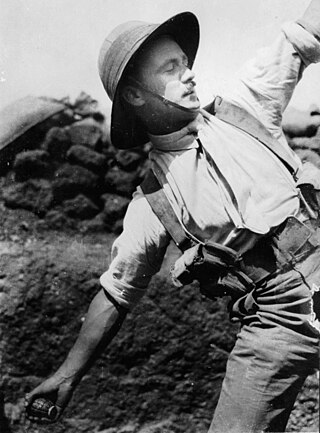
The British Salonika Army was a field army of the British Army during World War I. After the armistice in November 1918, it was disbanded, but component units became the newly formed Army of the Black Sea, and General Milne remained in command.

Field Marshal Sir John Greer Dill, was a senior British Army officer with service in both the First World War and the Second World War. From May 1940 to December 1941 he was the Chief of the Imperial General Staff, the professional head of the British Army, and subsequently served in Washington, D.C., as Chief of the British Joint Staff Mission and then Senior British Representative on the Combined Chiefs of Staff.

Field Marshal William Riddell Birdwood, 1st Baron Birdwood, was a British Army officer. He saw active service in the Second Boer War on the staff of Lord Kitchener. He saw action again in the First World War as commander of the Australian and New Zealand Army Corps during the Gallipoli Campaign in 1915, leading the landings on the peninsula and then the evacuation later in the year, before becoming commander-in-chief of the Fifth Army on the Western Front during the closing stages of the war. He went on to be general officer commanding the Northern Army in India in 1920 and Commander-in-Chief, India, in 1925.

Field Marshal William Edmund Ironside, 1st Baron Ironside, was a senior officer of the British Army who served as Chief of the Imperial General Staff during the first year of the Second World War.

Field Marshal Sir Archibald Armar Montgomery-Massingberd,, known as Archibald Armar Montgomery until October 1926, was a senior British Army officer who served as Chief of the Imperial General Staff (CIGS) from 1933 to 1936. He served in the Second Boer War and in the First World War, and later was the driving force behind the formation of a permanent "Mobile Division", the fore-runner of the 1st Armoured Division.

Field Marshal Sir William Robert Robertson, 1st Baronet, was a British Army officer who served as Chief of the Imperial General Staff (CIGS) – the professional head of the British Army – from 1916 to 1918 during the First World War. As CIGS he was committed to a Western Front strategy focusing on Germany and was against what he saw as peripheral operations on other fronts. While CIGS, Robertson had increasingly poor relations with David Lloyd George, Secretary of State for War and then Prime Minister, and threatened resignation at Lloyd George's attempt to subordinate the British forces to the French Commander-in-Chief, Robert Nivelle. In 1917 Robertson supported the continuation of the Battle of Passchendaele at odds with Lloyd George's view that Britain's war effort ought to be focused on the other theatres until the arrival of sufficient US troops on the Western Front.

Field Marshal Herbert Charles Onslow Plumer, 1st Viscount Plumer, was a senior British Army officer of the First World War. After commanding V Corps at the Second Battle of Ypres in April 1915, he took command of the Second Army in May 1915 and in June 1917 won an overwhelming victory over the German Army at the Battle of Messines, which started with the simultaneous explosion of a series of mines placed by the Royal Engineers' tunnelling companies beneath German lines, which created 19 large craters and was described as the loudest explosion in human history. He later served as Commander-in-Chief of the British Army of the Rhine and then as Governor of Malta before becoming High Commissioner of the British Mandate for Palestine in 1925 and retiring in 1928.

Field Marshal Frederick Rudolph Lambart, 10th Earl of Cavan,, known as Viscount Kilcoursie from 1887 until 1900, was a British Army officer who served as Chief of the Imperial General Staff, the professional head of the British Army, in the 1920s. After being commissioned into the Grenadier Guards in 1885, he served in the Second Boer War as a company commander, then served during the First World War as a brigade, divisional, corps, and army commander, and later advised the British Government on the implementation of the Geddes report, which advocated a large reduction in defence expenditure; he presided over a major reduction in the size of the British Army.

Field Marshal Philip Walhouse Chetwode, 1st Baron Chetwode, 7th Baronet of Oakley,, was a senior British Army officer. He saw action during the Second Boer War, during which he was present at the Siege of Ladysmith in December 1899. He saw action again during World War I on the Western Front, taking part in the First Battle of Ypres, and then in the Sinai and Palestine campaign during which he led his corps at the First Battle of Gaza in March 1917, at the Battle of Beersheba in October 1917 and the Battle of Jerusalem in November 1917.

General Sir Archibald James Murray, was a British Army officer who served in the Second Boer War and the First World War. He was chief of staff to the British Expeditionary Force (BEF) in August 1914 but appears to have suffered a physical breakdown in the retreat from Mons, and was required to step down from that position in January 1915. After serving as Deputy Chief of the Imperial General Staff for much of 1915, he was briefly Chief of the Imperial General Staff from September to December 1915. He was subsequently Commander-in-Chief of the Egyptian Expeditionary Force from January 1916 to June 1917, in which role he laid the military foundation for the defeat and destruction of the Ottoman Empire in the Arabian Peninsula and the Levant.
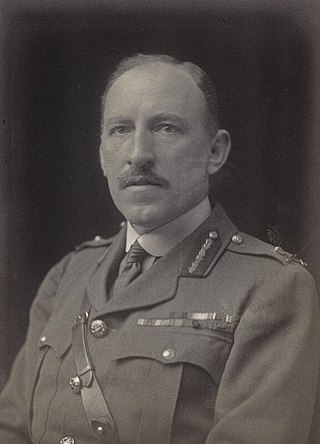
Field Marshal Sir Cyril John Deverell was a British Army officer who served as Chief of the Imperial General Staff (CIGS), the professional head of the British Army, from 1936 to 1937. Prior to his becoming CIGS, he fought in the Fourth Anglo-Ashanti War and the First World War, during which he commanded at battalion, brigade and division level, and later advised the British government on the importance of maintaining the capability to mount an Expeditionary Force for operations on mainland Europe in the years leading up to the Second World War.
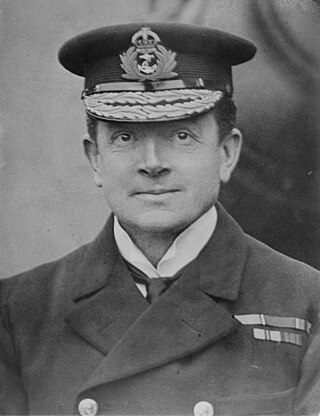
Admiral of the Fleet Sir Somerset Arthur Gough-Calthorpe, sometimes known as Sir Somerset Calthorpe, was a Royal Navy officer and a member of the Gough-Calthorpe family. After serving as a junior officer during the Fourth Anglo-Ashanti War, he became naval attaché observing the actions of the Imperial Russian Navy during the Russo-Japanese War and then went on to command an armoured cruiser and then a battleship during the early years of the 20th century.

Admiral of the Fleet Rosslyn Erskine Wemyss, 1st Baron Wester Wemyss,, known as Sir Rosslyn Wemyss between 1916 and 1919, was a Royal Navy officer. During the First World War he served as commander of the 12th Cruiser Squadron and then as Governor of Moudros before leading the British landings at Cape Helles and at Suvla Bay during the Gallipoli campaign. He went on to be Commander of the East Indies & Egyptian Squadron in January 1916 and then First Sea Lord in December 1917, in which role he encouraged Admiral Roger Keyes, Commander of the Dover Patrol, to undertake more vigorous operations in the Channel, ultimately leading to the launch of the Zeebrugge Raid in April 1918.
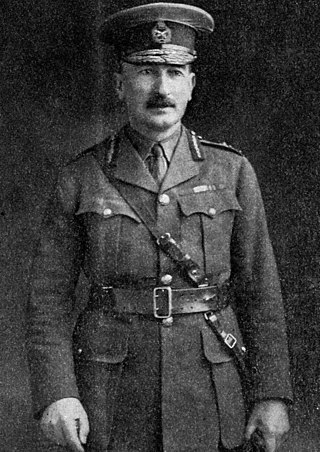
Field Marshal Sir Claud William Jacob, was a British Indian Army officer. He served in the First World War as commander of the Dehra Dun Brigade, as General Officer Commanding 21st Division and as General Officer Commanding II Corps in the Fifth Army. During the Battle of the Somme, his corps undertook the British attack during the Battle of Thiepval Ridge in September 1916 and the subsequent assault on St Pierre Divion during the Battle of the Ancre in November 1916. He remained in command of II Corps for the Battle of Passchendaele in Autumn 1917. After the War he commanded a corps of the British Army of the Rhine during the occupation there and then served as Chief of the General Staff in India. He went on to be General Officer Commanding Northern Command in India before temporarily becoming Commander-in-Chief, India and then taking over as Military Secretary to the India Office.
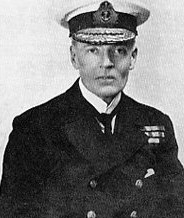
Admiral of the Fleet Sir Frederick Laurence Field, was a senior Royal Navy officer. He served in the Boxer Rebellion as commander of a raiding party and in the First World War as commanding officer of the battleship HMS King George V, flagship of Admiral Martyn Jerram at the Battle of Jutland in May 1916. He went on to be Commander-in-Chief, Mediterranean Fleet before serving as First Sea Lord during the early 1930s, in which role he dealt with the response to the Invergordon Mutiny in September 1931 and ensured the abandonment in 1932 of the 'ten-year rule', an attempt by the treasury to control defence expenditure by requesting the Foreign Office to declare whether there was any risk of war during the next ten years.
The British XVI Corps was a British infantry corps during World War I. During World War II the identity was recreated for deceptive purposes.

Maurice Paul Emmanuel Sarrail was a French general of the First World War. Sarrail's openly socialist political connections made him a rarity amongst the Catholics, conservatives and monarchists who dominated the French Army officer corps under the Third Republic before the war, and were the main reason why he was appointed to command at Salonika.

Field Marshal Sir Arthur Arnold Barrett, was a British officer of the Indian Army. He saw action at the Siege of the Sherpur Cantonment in December 1879 and at the Battle of Kandahar in September 1880 during the Second Anglo-Afghan War and went on to serve in the Hunza-Nagar Campaign in 1891. During the First World War he was General Officer Commanding the Poona Division which successfully took Basra in Mesopotamia in November 1914 and then Al-Qurnah in Mesopotamia in December 1914. He spent the rest of the War commanding the Northern Army in which role he took part in operations against the Mahsuds in Spring 1917. He saw action again as the senior British officer on the ground during the Third Anglo-Afghan War in 1919 before retiring in May 1920.

























